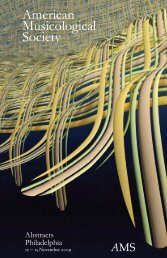Abstracts - American Musicological Society
Abstracts - American Musicological Society
Abstracts - American Musicological Society
Create successful ePaper yourself
Turn your PDF publications into a flip-book with our unique Google optimized e-Paper software.
44 Thursday Afternoon: Session 1- 37<br />
AMS/SEM/SMT New Orleans 2012<br />
dance, might think critically, too, about the various ways in which dancers have envisioned and embodied the audio-visual<br />
relation.<br />
My paper chips away at these issues with reference to a style of dance, dating from the turn of the twentieth century, known<br />
nowadays as “early modern.” The category embraces a cluster of dance practitioners who rejected the conventions of classical<br />
ballet—costuming, décor, the alternation of mime and pointe-work—in favour of a more spontaneous brand of bodily expression.<br />
To the early moderns, dance was a means of projecting the individual impulse to movement. Moreover, it was closely<br />
bound to music, especially nineteenth-century instrumental music, seemingly ripe for stage representation.<br />
Focusing on Loie Fuller, Valentine de Saint-Point and the lesser-known Jean d’Udine, this paper documents dancers’<br />
musical ambitions, detailed in primary sources (newspapers, specialist journals and autobiographical writings), yet largely<br />
overlooked in the secondary literature. I explore how modes of musical representation were rooted in contemporary ideology,<br />
from the biomechanics of perigenesis (evolution by means of protoplasmic replication) to Futurist theories of l’art cérébriste.<br />
More than this, I demonstrate how the dancers’ thoughts on music bring valuable insights to bear on the aesthetic debates and<br />
representational conundrums of Euro-<strong>American</strong> modernism. Suggesting more than a simple shift from representational art to<br />
abstraction, the dancers bring to critical discourse an “ideal union” of the arts, unseating established notions of authorship and<br />
mimesis, and articulating a prototypically modernist dilemma—what it means to represent at a particular historical moment.<br />
“Tonight I am Playing Madrigals from a Distant Country”:<br />
Interwar Japanese Musical Modernism and Settings of Fukao Sumako’s Poetry<br />
Kathryn Etheridge (Florida State University)<br />
Although “modernism” has been understood first and foremost as a Euro-<strong>American</strong>, multi-faceted aesthetic movement,<br />
modernism has also been conceptualized by Japanese and Western scholars alike as a historical and artistic epoch in Japan<br />
beginning in the early twentieth century. The products of interwar Japanese modernists—those who were active during the<br />
Taishō era (1912–26) and the first decade of the Shōwa era (1926–89)—have often been dismissed as vacant copies of Western<br />
artistic styles. Yet while Japanese artists drew heavily upon Western arts, they were also dealing with, and writing about,<br />
modernist aesthetic issues at the same time that Western artists were grappling with parallel issues, including internationalism,<br />
fragmentation, a substantial break from tradition, and a search for the artistic “new.” Japanese modernism should be<br />
viewed not simply as a phenomenon motivated by the influence or imitation of Western artistic movements; interwar artists<br />
transformed Western contemporary values and methods as they actively responded to developments within Japanese modernity.<br />
Evidence of interwar Japanese modernism can be found most especially in painting and literature, two fields which<br />
have received much scholarly attention in recent decades. Japanese music from this period has not yet acquired comparable<br />
consideration; however, interwar Japanese composers of yōgaku (art music in a Western style) expressed values similar to their<br />
visual and literary counterparts.<br />
Interwar Japanese modernism provides the conceptual framework for my examination of yōgaku compositions by Hashimoto<br />
Qunihico (1904–49) and Sugawara Meirō (1897–1988). Both composers set the poetry of Fukao Sumako, including her<br />
poem Fue fuki me (“Woman Piper”) from her anthology Mendori no shiya, announced in the Japanese journal Kaizō in April<br />
1928 immediately after she returned from her first trip to Europe. These settings reflect modernist values in different ways, as<br />
does the international network that formed between Fukao and various Japanese and European musicians during the 1920s<br />
and 1930s. In my paper I discuss how this musicultural complex informs interwar Japanese modernism, providing a new perspective<br />
to the growing body of scholarship on Japanese modernism that brings music to the forefront.<br />
“I hear those voices that will not be drowned”: Sentimentality under Erasure in Peter Grimes<br />
Christopher Chowrimootoo (Harvard University)<br />
Benjamin Britten’s Peter Grimes (1945) embodies a paradox: it is at once a testament to its composer’s popularity and a symbol<br />
of his neglect. While few could ignore the critical acclaim that the opera received following its now-legendary premiere,<br />
commentators have often exaggerated dissent as a way of defending the work from its own success. Even after the opera had<br />
been widely applauded by press and public alike, one critic continued to predict: “Peter Grimes will shock the fashionable<br />
first-nighters. The music is merciless, arrogant, tempestuous and makes no concession to the ear.” By imagining philistine opposition<br />
to Britten’s opera and focusing on its more challenging moments, commentators have been able to stylize the work as<br />
a “difficult,” modernist opera, which offers timely, even existential, meditations on postwar alienation.<br />
Through an investigation of the relationship between the work and its reception, I examine how Peter Grimes has invited<br />
precisely the kinds of selective responses it has resisted. I suggest that, in playing with themes of artistic alienation and “checking<br />
itself on the verge of melody,” the opera allowed audiences to imagine themselves as champions of a difficult and innovative<br />
artwork. I also explore how such images have been consistently thwarted by traces of sentimentality in the opera’s narrative<br />
and music.










